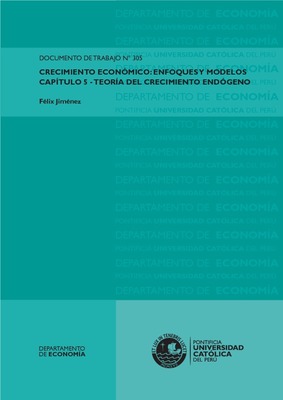| dc.contributor.author | Jiménez, Félix | |
| dc.date.accessioned | 2015-03-19T20:37:51Z | |
| dc.date.available | 2015-03-19T20:37:51Z | |
| dc.date.issued | 2010 | |
| dc.identifier.uri | http://repositorio.pucp.edu.pe/index/handle/123456789/46946 | |
| dc.description.abstract | Para explicar el crecimiento del producto per cápita, los modelos neoclásicos introdujeron exógenamente el cambio técnico. La nueva teoría del crecimiento surge como crítica a esta explicación y, al endogenizar el cambio técnico, abandona la función de producción neoclásica y los rendimientos marginales decrecientes del capital. La primera sección de este capítulo brinda una explicación más detallada del surgimiento de la teoría del crecimiento endógeno. En la segunda y tercera sección, se revisan las teorías de crecimiento endógeno de primera generación y de segunda generación. En la cuarta sección se analizan las principales herramientas teóricas utilizadas por los modelos de crecimiento endógeno: los retornos a escala constantes o crecientes, la introducción de factores de educación y capacitación en el trabajo, bajo la forma de capital humano, el desarrollo de nuevas tecnologías, la innovación y las instituciones. Finalmente, la quinta sección aborda las implicancias de política económica de los modelos de crecimiento endógeno. | es_ES |
| dc.description.abstract | In order to explain growth in per capita output, an exogenous technical change is introduced into the neoclassical models. The new growth theory emerges as a critical to this explanation and considers that technical change is an endogenous result. Hence, the new theory abandons the neoclassical production function and the decreasing marginal returns to capital. The first section of this chapter explains in more detail the emergence of the endogenous growth theory. In the second and third sections, we present the theories of endogenous growth of first and second generation. In the fourth section, we analyze the main theoretic tools used by the endogenous growth models: constant or increasing returns to scale, the introduction of education, job training and human capital, the development of new technologies, innovation and institutions. Finally, the fifth section revises the economic policy implications. | en_US |
| dc.language.iso | spa | es_ES |
| dc.publisher | Pontificia Universidad Católica del Perú. Departamento de Economía | es_ES |
| dc.relation.ispartof | urn:issn:2079-8466 | |
| dc.relation.ispartof | urn:issn:2079-8474 | |
| dc.relation.ispartofseries | Documento de Trabajo;305 | es_ES |
| dc.rights | info:eu-repo/semantics/openAccess | es_ES |
| dc.rights.uri | http://creativecommons.org/licenses/by-nc-nd/2.5/pe/ | * |
| dc.subject | Crecimiento económico | es_ES |
| dc.subject | Teoría económica | es_ES |
| dc.title | Crecimiento económico: enfoques y modelos. Capítulo 5 – Teoría del crecimiento endógeno | es_ES |
| dc.title.alternative | Economic growth: Approaches and models. Chapter 5: Endogenous growth theory. | en_US |
| dc.type | info:eu-repo/semantics/workingPaper | |
| dc.type.other | Documento de trabajo | |
| dc.subject.ocde | http://purl.org/pe-repo/ocde/ford#5.02.00 | |
| dc.publisher.country | PE | |
| renati.advisor.orcid | https://orcid.org/0000-0002-0585-238X | |


